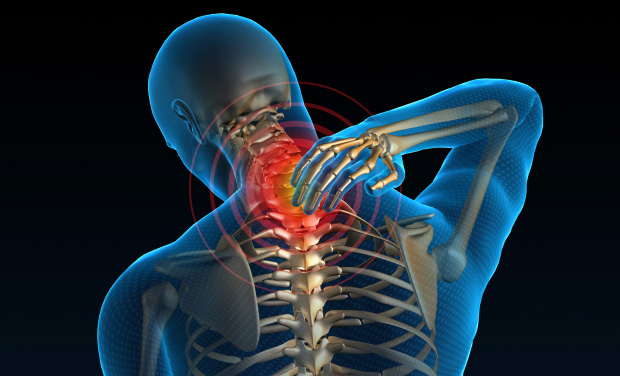It’s happened to us all before. You wake up with a stiff neck from an awkward night’s sleep and find pain with every turn of your head for the next day. When neck and upper back stiffness strikes, the pain can affect every move you make hindering your life and burying you in miserable agony. As our bodies age, aches occur quite frequently, and a stiff neck and back can become an expected nuisance every morning. Some upper back and neck pain can be treated with simple procedures, but there are quite a few dangers to ignoring your discomfort which could be an indication of a more serious underlying issue.
The most common cause of neck and upper back pain is muscle strain or a sprain in the soft tissue of these areas. The levator scapula, a muscle situated in the back and side of the neck, is acutely vulnerable to this type of injury. There is usually an event that causes this neck pain such as lifting heavy objects, trauma or prolonged poor positioning. Injuries sustained during sports activity, and excessive stress are also common causes of neck and upper back strain and sprain.
Ignoring a stiff neck or sore upper back for a prolonged period can be dangerous. There are several more serious conditions that accompany the stiff neck symptom that can be greatly improved through early detection and treatment.
Cervical Herniated Disc: Cervical herniated discs can occur the same way as a strain or sprain. Any trauma to the upper back or neck can cause the condition, but herniated discs can also start abruptly with no warning. When the inner core of the discs in your neck press on the sensitive nerve roots located in your spine it can create pain in both the neck and upper back as well as radiating nerve pain in the arms and fingertips. This condition can make the muscles feel weak and cause difficulty when completing normal daily tasks like brushing your teeth or driving a car.
Cervical Degenerative Disc Disease: Cervical degenerative disc disease can be the result of the normal wear and tear of the bones and muscles responsible for the mobility of your upper back and neck. Trauma and sprain can also be responsible for developing this condition. As time goes on, the discs separating the vertebrae in the neck and upper back region begin to deteriorate and cause numbness and tingling in the neck, arms, shoulders and fingertips. The degeneration of the discs can irritate the nerves in the spine and leave you in excruciating pain with the slightest movement.
Cervical Osteoarthritis: Cervical osteoarthritis, or neck arthritis, is another degenerative disease that begins with the degeneration of the facet joints in the spine. Most people ignore neck stiffness that increases in the early morning or at the end of the day, but this could be an early sign of cervical osteoarthritis. As the joints in the neck deteriorate cervical osteoarthritis sufferers experience pain and stiffness in the neck and upper back and headaches at the back of the head. The stiffness is usually alleviated with rest so, this condition is routinely left untreated until more serious issues develop. As cervical osteoarthritis puts increasing pressure on the spinal cord, patients are in danger of developing cervical myelopathy. Shooting pain, issues with walking and deterioration of fine motor skills accompany this serious condition. Untreated cervical osteoarthritis can also cause bone spurs to develop, and these bone growths can cause radiating pain in the arms and shoulders.
Treatment of neck and upper back pain can be as simple as performing daily exercises and stretches to alleviate stiffness and strengthen the muscles in these areas. It is essentially important to consult a physical medicine professional before adopting any new exercise routine to minimize the risk of potentially avoidable injuries. Hot and cold therapy packs are also an option for neck and upper back pain. The alternating temperature can encourage healthy blood flow to the muscles in your neck and help to reduce inflammation and nerve pressure.
Patients need to undergo diagnostic testing, which may include an MRI scan, to detect cervical degenerative disc disease and cervical osteoarthritis. Early detection and treatment of these conditions can significantly reduce pain and the impact on your normal daily life. Nonsurgical treatments include physical therapy, exercise, cervical traction, and bracing. Untreated cervical degenerative disc disease and cervical osteoarthritis can leave a patient dependent on anti-inflammatory medications and pain killers. Severely untreated conditions may warrant disc injections and spinal surgery.
Stiffness in your neck and upper back can be a common discomfort, but it is important to seek professional help when the pain persists. Your pain could be an indicator of a more serious underlying condition, and early detection can restore your normal mobility sooner with less invasive treatment and pain.

